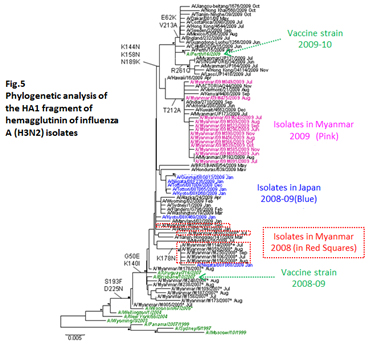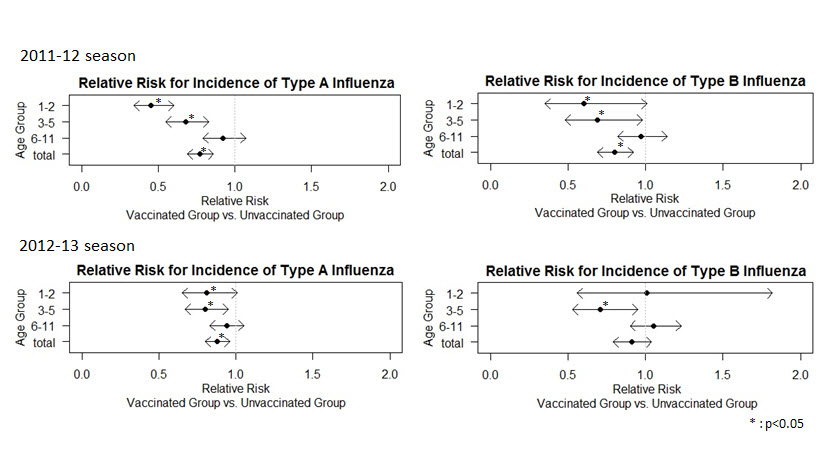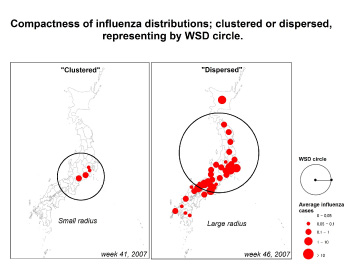1.Research Summary
In the field of International health, we focus on molecular epidemiological
analysis of viruses that cause respiratory infections such as influenza
viruses and respiratory syncytial (RS) viruses and we monitor for the emergence
of drug-resistant viruses. In recent years, we have been conducting spatial
analyses of patterns of virus transmission and accumulation using a geographic
information system (GIS) and endeavoring to apply the GIS method to the
field of social epidemiology.
We provide detailed information about our research outlines and results
on our website.
2.Research Group
3-1.Molecular epidemiology of infectious diseases Group
Research subject
3-2.GIS Group
Research subject
4.Research Results
[Area] International health (molecular epidemiology)
[Research subject1]
Comparison of influenza virus strains isolated in Myanmar from 2007 to 2010 with epidemic strains in Asian countries using genetic analysis
[Description]
We have been conducting molecular epidemiological studies and antiviral
resistance studies on influenza viruses in collaboration with on-site researchers
based in two cities Yangon and Nay Pyi Daw in Myanmar since 2004. We found
that new influenza virus strains emerge in Myanmar every year earlier than
in the influenza season in Japan through the molecular epidemiological
studies in Myanmar. We have confirmed that Myanmar is an important country
for early identification of epidemic strains in China, where new influenza
strains emerge before circulating worldwide to cause seasonal epidemics.
In addition, we had already isolated the A/H3N2 strains in Myanmar in 2008,
which were circulated in 2008-2009 influenza season in Japan (6 months
earlier than the isolates in Japan). Thus, we have revealed that Myanmar
is one of important countries for the future selection of vaccine strains.
(DapatC. et al. 2009)
[Photographs]

The A/H3N2 strains which were circulated in 2008-2009 influenza season in Japan, had been isolated in Myanmar in 2008 (6 months earlier than in Japan).In addition, the A/H3N2 Myanmar isolates in 2009 showed different antigenicity as compared to circulated A/H3N2 strains in the last season, and also were similar to A/Perth/6/2009 strain, a vaccine strain for the 2009-2010 season. These results highlight the importance of influenza virus surveillance in Myanmar.
[Area] International Health (Clinical epidemiology)
[Research subject2]
Estimation of seasonal influenza vaccine effectiveness among children in Japan
[Description]
We estimated the influenza vaccine effectiveness for children 1-11 years
of age using rapid test kits in Isahaya City, involving 28,884 children-years,
over two consecutive influenza seasons(2011-12 and 2012-13) from an influenza
registration program organized by the Isahaya Medical Association for all
pediatric facilities in the city. The trivalent influenza vaccine has a
significant protective effect for children 1-11 years of age against influenza
A and B infection in the 2011-12 season and against influenza A infection
in the 2012-13 season in a community in Japan.
(Suzuki et al. 2014)
[Photographs]

[Area] International Health (Molecular epidemiology)
[Research subject3]
Spatial analysis of Influenza
[Description]
In cooperation with the Isahaya City Medical Association in Nagasaki Prefecture,
we collect data from all patients who visit cooperating medical facilities
for influenza and perform an epidemiological analysis of these patients.
In winter, when influenza is prevalent, we create a map of the incidence
rate of influenza based on weekly information about patients with influenza
and provide it to the Medical Association. Meanwhile, we showed a relationship
between the influenza epidemic peak and the spatial distribution of influenza
in Japan using Weighted Standard Distance, an indicator for spatial analysis,
based on data from stationary influenza observation facilities nationwide
under the scheme of the National Infectious Disease Surveillance Center.
(Shobugawa et al.)
[Photographs]

Above Figure: Left panel shows clustered outbreaks in a limited region with small WSD circles and that on the right shows nationwide dispersed outbreaks with large circles. This study demonstrated a relationship between circle sizes and epidemic peak timings.
Please see the International Health website for a detailed description of our research.
